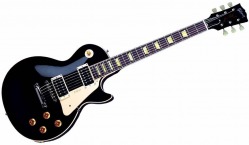The Basics

The electric and acoustic guitars are not that different. Both have six strings, a long neck with frets, and tuning pegs to tighten or loosen the strings. The frets show the position where if you press down on the string (making it shorter or longer) and pluck that string, a new pitch will sound. In these ways the electric and acoustic guitar are the same instrument, but they can create very different sounds. In this article we will cover the science behind one of the most unique instruments in the world, and we will also cover the different ways that one could play an electric guitar.
Electric Guitar with the Amp

Without an amplifier, the electric guitar doesn't make very much sound. The only reason an acoustic guitar doesn't need one is because when you strum the strings the vibrations travel into the sound hole and throughout the hollow body to make the sound. An electric guitar doesn't have a hollow body or a sound hole. Instead it has what is called magnetic pickups. When you strum the guitar the pickups sense the vibrations of the strings and then sends them to the amp which is hooked up to the guitar. The pickup also consists of wire coils wrapped around it. These coils take those vibrations and transform the motion energy into electrical energy which is sent through the wires to the amp which produces the sound at a higher volume. In the picture above the pickups are separated for each string whereas the one to the left has only one bar magnet for all six strings. The same job is essentially done but it all depends on the kind of sound you want to hear. In most guitars there are multiple pickup bars that are located in different positions on the guitar. With this you get a different distinct sound out of each pickup. Now, not all electric guitars are the same but for the generic, solid bodied electric guitar, that is the common way to produce sound through string vibration and sound amplification.
Bends and Vibratos
A very common technique for playing the electric guitar is bending. This is where a note is played and while still holding down the fret, the player bends the string up or down to easily go to another note without having to change your finger placement. It also allows you to play all those notes in between two frets. This makes the electric guitar a very unique instrument because most instruments don't have those capabilities. Another playing technique that can produce a very cool sound is a vibrato. It's very similar to bending but instead of a long, single bend, it's more of very quick multiple bends. The object is to make an effect that sounds like your guitar is vibrating. To get a solid vibrato, it requires very fast and strong wrist motions that can move the string up and down at a rapid pace. A similar technique is used on the violin, viola, and cello. Because of these playing techniques the electric guitar has a vast capability of producing sounds and effects in your songs.

If you want to learn more about how guitars are made just click on this picture.
This information was adapted from howstuffworks.com.
Fun Guitar Facts
1. In 2001 a huge guitar fan actually married his guitar! Chris Black is the proud husband of his Stratocaster.
2. Jimi Hendrix's tombstone has a Fender Stratocaster carved into it.
3. The famous guitar creater Les Paul, once got really drunk one night and created his very own electric banjo. Sadly that didnt earn him much recognition.
4. The smallest guitar in the world is 10 micrometers long and the strings are only 50 nanometers wide!
5. In 1952, Gibson didn't use serial numbers on their guitars. So if you own a Gibson solid body without a serial number on it, then its probably from the 50's.
2. Jimi Hendrix's tombstone has a Fender Stratocaster carved into it.
3. The famous guitar creater Les Paul, once got really drunk one night and created his very own electric banjo. Sadly that didnt earn him much recognition.
4. The smallest guitar in the world is 10 micrometers long and the strings are only 50 nanometers wide!
5. In 1952, Gibson didn't use serial numbers on their guitars. So if you own a Gibson solid body without a serial number on it, then its probably from the 50's.
